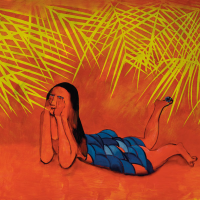108. CHARLES BLACKMAN

With a career as distinct as it was diverse, Charles Blackman has a knack of teasing out universal truths through his own unique candour. A founding member of the Antipodeans movement, Blackman created figurative imagery surrounding personal themes, holding the view that artmaking was primarily autobiographical.1 A common fibre that runs powerfully through Blackmans oeuvre and is highlighted in the present work is the recollection of the familiar, whether that is, place, people or feeling. These commonalties can be traced back to his first significant works dubbed the Schoolgirl series created throughout the 1950s where Blackman first explored the duality of dreams and reality. He painted the schoolgirl figure often alone and depicted in eerily empty streetscapes of his imagination. Often painting in series, his work mirrored his own personal biography. Frequently reading aloud to his first wife Barbara who was blind, Blackman found that this practice allowed him to absorb imagery more deeply. From this, his widely acclaimed Alice sequence was born, based on Lewis Carrolls Alice in Wonderland which highlighted works of vivid and surreal imagination. By the end of the 1970s, Blackman has commenced a new relationship with Genevive de Couvreur that he celebrated through a collection of paintings comprising literary, and musical themes.
Creating a space for himself within Australian art, Blackman has formed an easily recognisable style that is so inherently his own. The present work, Wahine (The Blue Dress) was created in the latter part of his career and highlights the critical building blocks of his oeuvre. Blackman had returned to far north Queensland and had a studio on Clifton Beach where he lived on and off for a few years. He was still married to Victoria Bower who was possibly the subject of the work. Drawing from the environment around him the tropical gardens of the beach coves influenced his work, along with the vibrant colour palette.2 Wahine (The Blue Dress) is a celebration of colour and light, bathed in the glow of ruby hued sunlight. In typical form, the woman lies recumbent, her head sitting heavily in her hands. The woman does not engage directly with the viewer. She gazes from behind her fingers, looking beyond her surroundings and invites the viewer into her own world, and in turn the world of the artist. Wahine is the Polynesian name for woman, and more commonly is used to refer in contemporary terms to a young female surfer. The image may have derived from Blackmans surroundings, but the use of the Wahine figure alerts the audience to his subconscious.
Blackman fuses his innovative style and poetic musings within the mundane trappings of his environment. Bryan Robertson notes in 1961 He has made icons from the commonplace material of domestic life. The fragile gestures among people around us are caught, and made eloquent.3 The present work epitomises the originality of Blackmans oeuvre and further cements his iconic position in the history of Australian art.
Footnotes:
1. Shapcott, T., Focus on Charles Blackman, University of Queensland Press, Brisbane, 1967, p.11
2. Christabel Blackman in email correspondence with the author, October 2022
3. Bryan Robertson, quoted in Shapcott, T., op. cit., p.36
Clementine Retallack